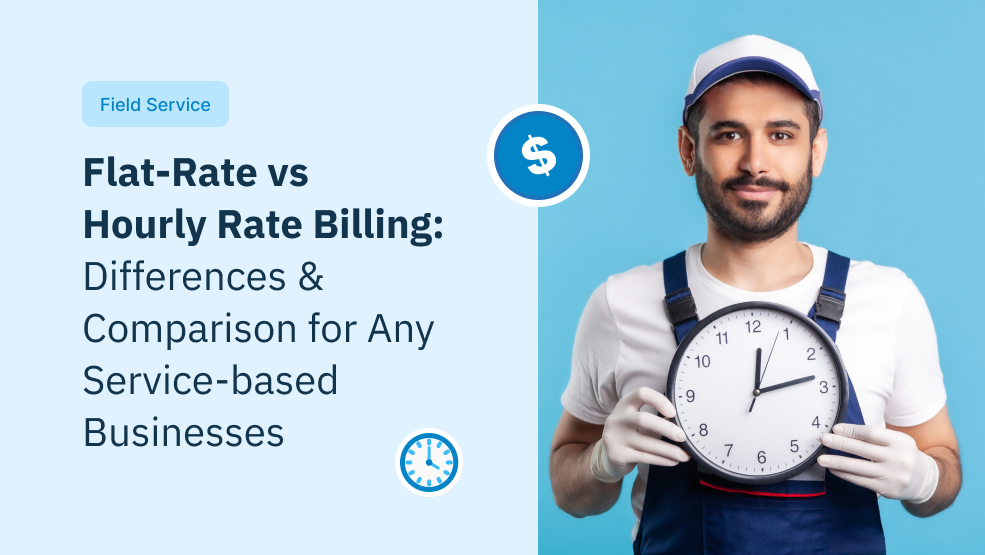Billing. It’s one of the most important decisions you’ll make when starting a service-based business. Do you go with a predictable flat rate or bill by the hour? Both have major pros and cons. Stick around as we break down flat-rate versus hourly billing to help you pick the best fit. We’ll look at how each method works, compare the risks and rewards, and explore hybrid options. Whether you’re just starting out or considering a switch, you’ll have all the info you need to choose a billing model that sets your customers and your business up for success.
Understanding flat-rate billing
Fixed scope
With flat-rate billing, you charge a single fixed price for a clearly defined project or service. This could be anything in your range of services you offer. The key is determining the precise scope of work upfront before quoting a price. Any services outside of that fixed scope would require a separate agreement and payment.
Predictability and budgeting
For both you and your customers, flat-rate billing offers predictability and easy budgeting. Your customers know exactly what services they’ll receive and how much they’ll pay. You can also more accurately calculate revenue and profits for the year.
However, this predictability comes with risks like underestimating the time required or dealing with scope creep. If you haven’t accurately assessed the complexities of a service project, you may end up putting in more hours than planned without additional pay. You’ll need to build safeguards into your contracts to account for reasonable changes in scope.
Transparency
With a fixed price published upfront, flat-rate billing is transparent for customers. They feel more in control of costs and less worried about meters running in the background. This can build goodwill and word-of-mouth referrals.
Of course, for certain ongoing or open-ended services, flat-rate billing isn’t practical or profitable. In these cases, hourly billing may be better suited. But for many defined projects or service packages, flat-rate billing can benefit both you and your customers. If applied strategically, it may help build a reputation for value and transparency.
How to calculate flat-rate costs in service businesses
To price flat-rate services accurately, you need to determine your costs. Calculate direct costs. First, tally your direct costs like materials, supplies, and third-party services. If it’s a project requiring lots of resources, keep good records of expenses. You’ll want to build in a profit margin, so don’t just pass direct costs onto the customer.
Determine your hourly rate
Figure out what you need to charge per hour to cover overhead and profit. As a rule of thumb, aim for 2-3 times your salary. So if you pay yourself $50 per hour, charge $100-150 per hour. This ensures you account for expenses like rent, insurance, marketing, and administration.
Estimate the hours
For a new service, time yourself doing the work to determine how long it takes. Pad this by 10-25% to account for inefficiencies. As you get more experienced, you’ll get faster and more accurate with your estimates. Be very conservative until you’ve done the work a few times.
Consider value to the customer
The customer’s perceived value of your service also determines what you can charge. If your work could make or save them a lot of money or hassle, you can likely increase your rate. Make sure any flat-rate quote communicates the value you’ll provide.
Review and adjust
Once you start providing the service, track your actual time and costs. If you’re coming in under or over budget, adjust your flat rate for the next project. It may take a few iterations to find the sweet spot. But with experience, you’ll get better at calculating a fair flat rate, which benefits both you and your customers.
Understanding hourly-rate billing
Let’s dive into how hourly billing works. With this method, you charge customers based on the actual time you spend working on their project. For each hour of work, you bill them your standard hourly rate. This means longer or more complex projects will cost more, while shorter or simpler ones will cost less.
Flexibility and accuracy
The major benefit of hourly billing is flexibility. You can adapt to the scope and needs of each project without worrying if you’ve undercharged. Hourly billing also provides an accurate reflection of the effort and resources required. Customers understand they are paying for the actual time spent addressing their needs.
Challenges: Perception and unpredictability
However, some customers may perceive hourly billing as a way for you to overcharge them. They may feel like the clock is always running, even for minor tasks. Hourly billing also lacks predictability, making it difficult for customers to budget. The total cost of a project remains uncertain until all work is completed.
Administrative requirements
Hourly billing has additional administrative requirements. You need to closely track the time spent on each task and project to properly bill customers. Using time-tracking software can help, but it still demands effort and diligence to log all hours worked, review time entries, and bill customers accurately.
When to use hourly billing
Hourly billing works well for open-ended projects where the total time required is unclear. It is also good when you have limited experience with a particular type of project or customer and need flexibility. Once you become very familiar with a customer or type of work, you may consider switching to flat-rate billing for efficiency and predictability.
Simply put, hourly billing provides an adaptive, accurate way to charge customers based on the effort involved in their projects. However, it also brings challenges around perception, unpredictability, and administration that you’ll need to consider based on your business and customer needs. With the right management, hourly billing can be an effective method for service providers.
How to calculate hourly-rates for service businesses
Determine your business costs
The first step is calculating your overall business expenses. Factor in costs like rent, utilities, equipment, supplies, insurance, and employee salaries. Don’t forget to include the salary you pay yourself. Add up all these costs for a yearly total, then divide by the number of hours you and your employees will work to determine your ‘cost per hour’ figure.
Add a profit margin
You need to make a profit to keep your business sustainable. A good rule of thumb is to add at least 30-50% to your cost per hour. For example, if your costs total $50 per hour, charge $65-$75 per hour. The higher your profit margin, the faster your business can grow. But be careful not to price yourself out of your market.
Consider the competition
See what other businesses in your area and industry are charging for similar services. You want your rates to be in line with competitors so you can attract customers. Their fees give you a good benchmark for the range you can consider. You may need to adjust up or down depending on your experience, reputation, and business goals.
Package deals and retainers
Offering package deals, retainers, or monthly billing arrangements provide predictability for your customers and stability for your cash flow. For example, charge a flat monthly fee for a certain number of hours or a discount if customers prepay for a block of time. These options encourage customer loyalty and retention.
Make adjustments
Don’t be afraid to change your rates over time based on your growing experience, increased costs of living, and inflation. Incremental increases, say 3-5% per year, are typically accepted by customers and help ensure your rates remain aligned with the value you provide. When increasing rates for existing customers, be sure to give them plenty of notice and explanation.
In the end, determining your hourly rates is an imperfect science. But following these steps will get you close, and you can then fine-tune based on how customers respond and what works for your business model. The rates you charge say a lot about your confidence and value proposition, so take the time to calculate them carefully.
Flat-rate vs Hourly-rate: Head-to-Head Comparison
Cost predictability
With flat-rate billing, both you and your customers know the exact price upfront. This makes budgeting and planning straightforward for all parties involved. Hourly billing, on the other hand, provides no cost certainty since the final bill depends on the actual hours spent. While hourly billing may seem fairer as customers pay only for work done, the unpredictability can be stressful for those on a tight budget.
Scope creep management
Flat-rate projects often face scope creep, where customers ask for extra work beyond the agreed scope. This reduces profitability if not properly managed. With hourly billing, any additional work is charged for, so scope creep is less of an issue. However, some customers may perceive being ‘nickel and dimed’ if charged for every small change. Finding the right balance is key.
Administrative burden
Flat-rate billing generally has lower administrative needs as you only need to track the fixed price for the project. Hourly billing requires meticulous timekeeping to document hours spent on tasks, meetings, calls, and other billable time. This additional effort reduces productivity and drains resources. Many businesses struggle with consistent and accurate time-tracking.
Perceived value
Customers often perceive flat-rate fees as a better value since the price is fixed, whereas hourly billing can seem expensive if total hours are high. However, flat-rates risk being too low if you underestimate the work required. Hourly billing, on the other hand, reassures customers they are only paying for actual work done. Managing customer expectations upfront is important for either method.
In the end, the best approach for your business depends on factors like your industry, customer, business goals, and available resources. Many find success with a hybrid model, using flat-rates for some services and hourly billing for others. Whichever method you choose, continuous reevaluation and adaptation to market changes will serve you well. With the right billing strategy in place, you’ll achieve sustainable success and satisfied customers.
Pros and cons of flat-rate and hourly-rate billing
Simplicity vs flexibility
Flat-rate billing is straightforward, with a fixed price for a defined scope of work. This simplicity offers predictability for both you and your customers regarding cost and budgeting. Hourly billing, on the other hand, provides flexibility to adapt to changes in scope and time requirements. The downside is a lack of cost predictability as projects can extend in unforeseen ways.
Risk and reward
With flat-rate billing, you assume the risk of underestimating the time required, which could reduce your profit margins. However, if you overestimate, you benefit from the extra time saved. Hourly billing passes the risk to customers, who could end up paying more than a flat-rate if the project timeline expands. However, they also benefit if the work takes less time than estimated.
Perception and trust
Some customers perceive flat-rate billing as simpler to understand and more transparent. Others see hourly billing as a fairer reflection of the actual work done. A clearly communicated scope of work and reasonable rates are key to building trust in either model. Hourly billing, in particular, requires meticulous time-tracking to demonstrate value and prevent perception of overcharging.
Administrative requirements
Flat-rate billing has lower administrative demands as you only need to track the overall project, not individual hours. Hourly billing requires robust timekeeping to record hours spent on tasks, meetings, calls, and so on. This additional effort, however, provides data to help improve estimations and efficiencies over time.
The right choice for your business depends on factors like your industry, customer base, company goals, and resources. A hybrid approach, combining elements of flat-rate and hourly models, may offer the optimal balance of simplicity, flexibility, risk, and reward for your needs. With continuous evaluation and adaptation, you can achieve the best results for your customers and your bottom line.
Choosing the right approach for your service business
Type of service you offer
The type of service you offer will significantly impact your choice of billing method. If you provide a highly customized, variable service where the scope of work can often change, hourly billing is probably better suited. For more standardized services where the process and outputs are consistent, a flat rate may be appropriate. Think about how well-defined your services are and how much variability or customization is typically required.
Your customer base
Your customers’ needs and preferences should also guide your decision. If your customers typically prefer fixed, predictable pricing for budgeting purposes, a flat rate would satisfy them. However, if your customers value flexibility and transparency in billing, hourly rates may be appealing. Consider sending a survey to gain insight into their priorities.
Risk tolerance
How much risk and uncertainty are you comfortable with as a business owner? Flat-rate billing provides more predictable revenue but risks under-estimating the time required for the work. Hourly billing ensures you’re paid fairly for your time but revenue can be hard to forecast. Assess your risk tolerance and how much stability your business requires.
Resources and expertise
The strengths and capabilities of your team will also determine what billing methods you can properly implement. To charge effective flat rates, you need to have standardized processes and a good understanding of the time required for various services. Hourly billing is easier to implement but still requires the ability to accurately track time spent on customer work. Evaluate how proficient your team is in estimating and managing different types of projects.
As with many business decisions, there may not be a single ‘right’ choice of billing method for your company. The ideal approach is often a hybrid one, combining elements of flat-rate and hourly billing. It may also change as your business grows and you gain experience. The key is to start with what you know can work well, then adapt based on feedback and lessons learned. With time, you’ll determine the perfect formula for your success and your customers’ satisfaction.
Legal considerations
Once you’ve selected either flat-rate or hourly billing, there are a few other things to keep in mind. For starters, make sure your method is clearly communicated to customers before starting a project. Put details like rates, payment terms, inclusions/exclusions, and policies in writing to avoid confusion and disagreement later on.
You’ll also want to consider how you’ll track time and expenses for billing and accounting purposes. Many service providers use time-tracking software, spreadsheets, or project management tools for this. Accurate time-keeping is important for profitability, especially if you bill by the hour. For flat-rate projects, time-tracking can help determine if estimates were accurate and make adjustments for future projects.
Speaking of estimates, provide them whenever possible, even for flat-rate work. Estimates give customers an idea of the scope of work and total cost, allowing them to budget properly. For hourly billing, estimates also set expectations about how much time a task may take. Be transparent that actual hours may vary, but estimates demonstrate your experience.
Review and revise your rates periodically based on industry standards, costs of living, and business expenses. It’s a good idea to increase rates incrementally over time as your experience and skills improve. Grandfathering in existing customers at current rates is common, but be very careful not to take on unprofitable work just to keep customers.
Lastly, stay up to date with the legal and tax regulations regarding billing in your area. Requirements like issuing invoices, collecting sales tax, 1099’s, and income reporting all depend on your billing method and location. Make sure you understand the rules to avoid penalties. With the right considerations and best practices in place, the billing method you choose can help set your business up for success and satisfied, loyal customers. But as with any business process, continue to evaluate how it’s working and make changes to optimize your results.
Final thoughts
So, in the end, you need to find the billing approach that works best for your business and customers. There’s no one-size-fits-all solution here. Take some time to experiment with different models, and don’t be afraid to get creative with hybrid options. The key is keeping an open mind, staying flexible, and constantly evaluating what billing method allows you to run a sustainable, profitable business while keeping your customers happy. Tweak and tailor things over time as your needs change. And remember to stay up-to-date on any legal or tax considerations based on where you operate. Finding the right billing fit for your unique situation is crucial for success. And, that’s not all.
Achieving success in service-based businesses depends on providing excellent services and implementing effective pricing strategies. Zuper offers solutions tailored to optimize workforce operations and streamline back-office functions, aiding businesses in enhancing their services and attracting more customers. By utilizing Zuper’s proposal feature, your business can design personalized proposals to meet customer needs and maintain sustainable pricing, ultimately fostering your business growth. Try a demo here and see how Zuper can help you.






